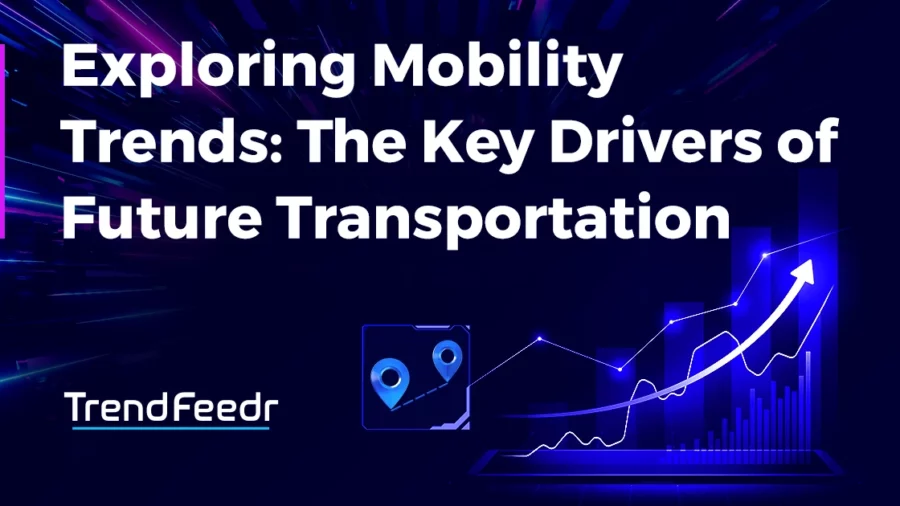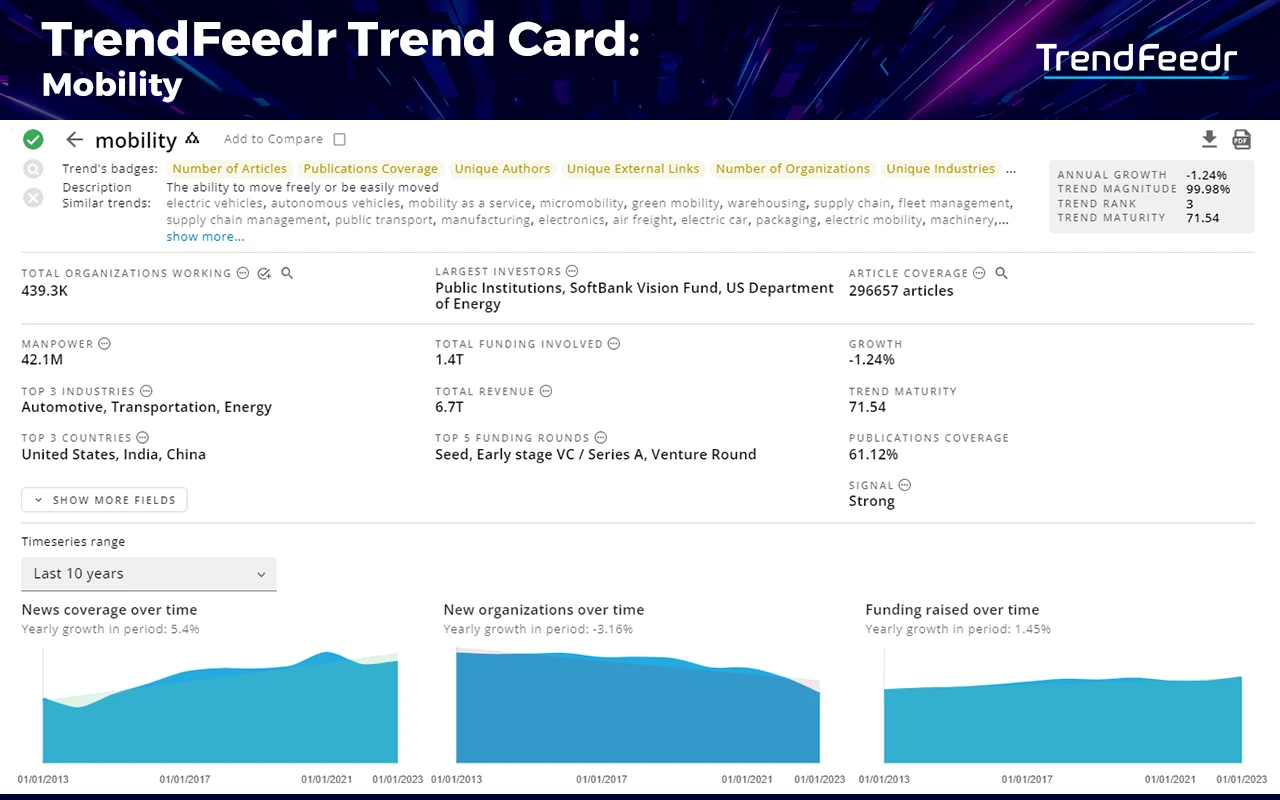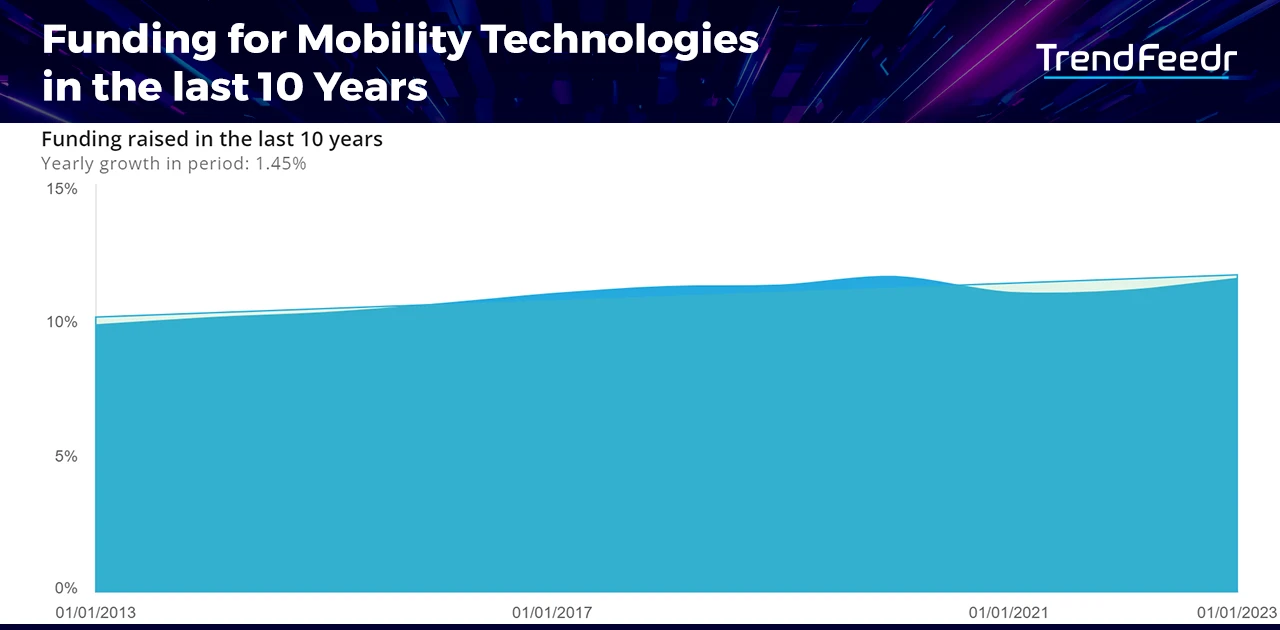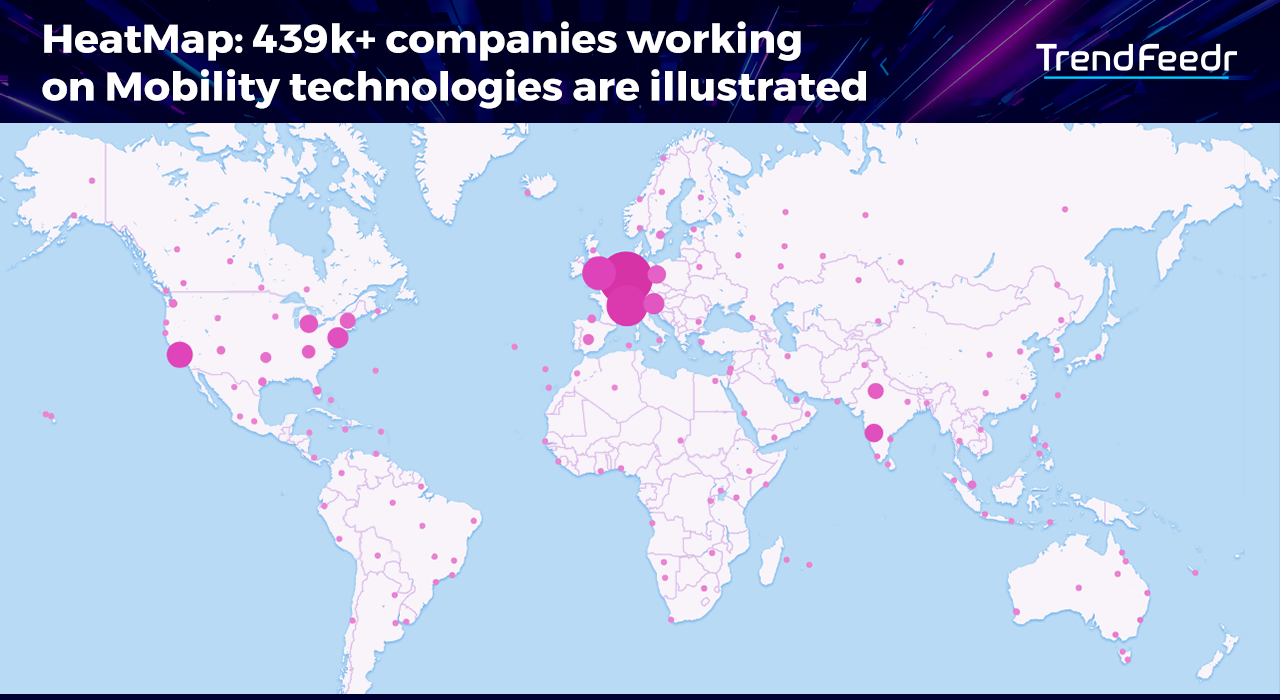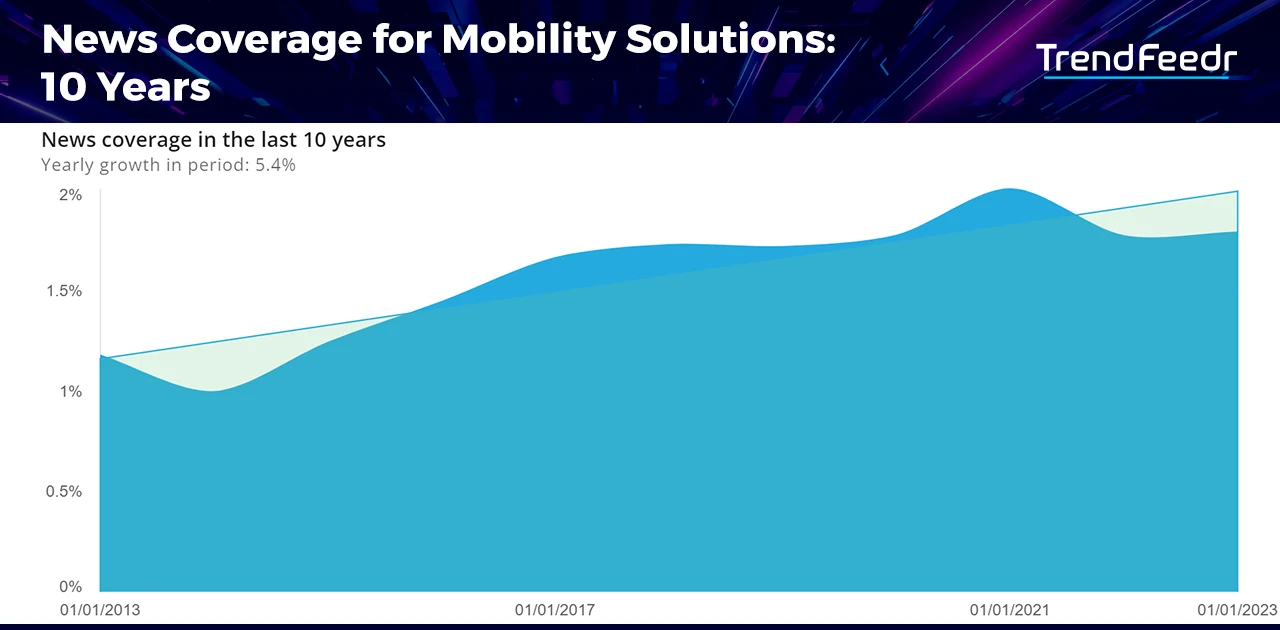There are over 1 billion vehicles on roads globally, making it crucial to understand the trajectory of mobility trends. For instance, by 2030, it is projected that 70% of the world’s population will reside in urban areas. This massive shift underscores the dire need for smarter, more efficient mobility solutions.
Besides, the average U.S. motorist spent 51 hours sitting in traffic last year, forcing cities to optimize public transportation and encourage alternative modes of transportation. One example of such a solution is the e-scooter. A few years ago, they were a novelty. Today, cities from San Francisco to Singapore have adopted them as a mainstream mode of transport.
Coming to the environmental impact, urban transportation accounts for about 40% of all CO2 emissions from road transport and up to 70% of other pollutants from transport. This further highlights the importance of efficient transportation solutions.
Key Takeaways
- Mobility’s Meteoric Rise: Mobility ranked 3rd among more than 20,000 trends and with a magnitude score of 99.98%, its impact is substantial and demands serious consideration.
- Diverse Mobility Sub-Trends: The latest trends in mobility like Electric Vehicles, Autonomous Vehicles, Mobility as a Service, Micromobility, and Green Mobility, companies are redefining the future of transportation.
- Steady News Coverage: The consistent growth of 5.4% in news coverage over the last decade underlines mobility’s significance and evolving nature.
- Corporate & Funding Overview: Approximately 439.3K entities are participating in the mobility sector, collectively attracting investment capital of around US $1.4 trillion.
- Big Backers include Public Institutions, SoftBank Vision Fund, and the US Department of Energy, infusing billions into pioneering mobility ventures.
- Regional Mobility Hotspots include countries like the United States, China, India, Germany, and Canada, along with cities such as London and New York City, Melbourne, Sydney, and Bangalore.
Table of Contents
- Understanding Mobility Trends
- Mobility Performance Analysis – How Efficient are Smart Transportation Solutions?
- Key Mobility Trends & How Companies are Advancing them
- How Mobility Disrupts Industries
- Who Invested in Mobility?
- Geographical Activity: Mapping the Mobility Movement
- Future Outlook of Mobility
We conducted this in-depth research on global mobility trends leveraging TrendFeedr, our all-in-one trend intelligence platform. TrendFeedr identifies future industry and tech trends via advanced, proprietary algorithms. With a focus on trend discovery, clustering, and analysis, the AI-powered platform screens thousands of trends each week to track their development and curate actionable insights.
Mobility stands out among the 20K+ trends and technologies tracked by TrendFeedr. Here’s why:
- It ranked at number 3 – mobility has risen to become a top global trend, addressing the issue of road congestion, improving accessibility, and building a safer transportation environment.
- When compared to other trends, the mobility trend stands out with an impressive magnitude of 99.98%, indicating an exceptional rate of adoption.
- The ascent of mobility is being propelled by technological advancements, increased urbanization, and a growing emphasis on sustainable and equitable transportation solutions.
This article provides an in-depth exploration of current and future mobility trends, covering aspects such as performance, investment as well as regional and future trends.
Understanding Mobility Trends
Mobility trends harness the power of technology to redefine the entire transportation landscape. These trends are more than just getting from point A to point B.
What are trends in mobility?
Several key trends are shaping the mobility sector, including the electrification of vehicles, the development of autonomous driving technology, and the rise of micromobility solutions. Other trends include the growth of mobility-as-a-service (MaaS), shared mobility, and urban air mobility (UAM), as well as the integration of connected infrastructure and multi-modal transportation. You’ll learn more about them throughout the article.
What are the most transformational trends in mobility today?
The rise of electric vehicles (EVs) involves the development of entirely new vehicle designs, charging infrastructure, and energy management systems. The dynamics are also shifting from ownership to shared use with emerging options such as car-sharing, ride-hailing, and micromobility. For example, Bird and Lime e-scooters have become urban staples in many cities, exemplifying the micromobility trend. Self-driving technology is also part of the transformation trends revolutionizing our roads, with many companies already conducting advanced trials.
What are emerging technologies in mobility?
To make roads smarter and safer, connectivity and especially vehicle-to-everything (V2X) communication is being adopted. These connectivity technologies enable vehicles to communicate with each other and with infrastructure. AI and machine learning are being used for predictive maintenance, route optimization, and traffic management. Blockchain technology is also leveraged for secure and transparent transactions, especially in shared mobility platforms.
Moreover, autonomous vehicles use a combination of LiDAR (light detection and ranging), radar, and cameras to perceive their surroundings. Coupled with advanced machine learning algorithms, they process vast amounts of data in real-time to make driving decisions. For instance, Tesla’s autopilot system is at the forefront of electrification and autonomous driving. Further, Waymo, an offshoot of Google, is making rapid progress in the autonomous vehicle space, having covered millions of test miles on public roads.
Mobility Performance Analysis – How Efficient are Smart Transportation Solutions?
Presenting Mobility Trend Card – a comprehensive overview of the transportation industry, including insights into key players and workforce expertise. Additionally, it offers access to important financial metrics, such as capital allocation and revenue streams, from leading investors driving the industry forward. Our analysis also explores the far-reaching impact of mobility solutions on various sectors, regions, and urban centers, providing a complete understanding of its evolution.
The mobility trend has an impressive 99.98% magnitude, demonstrating its significant impact and presence in our current world. With a rank of 3 among 20K+ trends, mobility is undoubtedly a powerful force in the industry. The trend’s maturity is at 71.54% out of 100%, suggesting that while it has reached a mature stage, there are still numerous opportunities for growth and innovation.
Looking for all trends related to mobility?
Key Mobility Trends & How Companies are Advancing Them
According to the newest numbers from TrendFeedr, 439.3K companies specializing in mobility are also at the forefront of innovation of other emerging trends. Here’s a look at what they’re doing to shape the future of transportation:
Electric Vehicles (EVs)
- EVs are a sustainable solution to the world’s transportation needs. By using electricity as fuel, they reduce emissions and contribute to a cleaner environment.
- With 27.6K organizations investing in this trend and receiving funding of US$232.2B, the electric revolution is well underway.
- Further, it is powered by a strong workforce of 2.5M individuals.
Autonomous Vehicles (AVs)
- AVs use advanced AI and sensor technology to navigate and control the vehicle, resulting in safer and more efficient roads.
- With 8206 organizations leading the charge, this trend has attracted US$88.9B in funding.
- Moreover, it is supported by a workforce of 745.6K individuals.
Mobility as a Service (MaaS)
- MaaS, enabled by a range of digital platform solutions, integrates various transport services into centralized, user-friendly interfaces.
- Such platforms offer on-demand access to transportation, route planning, and payment options, streamlining the travel experience.
- With 788 organizations driving this trend forward and securing US$6.7B in funding, MaaS is revolutionizing the way we think about transportation.
- Further, a workforce of 68.8K individuals is working to realize this vision.
Micromobility
- Micromobility addresses short-distance urban commutes by offering compact, and often shared, transport options such as e-scooters and e-bikes.
- With 1489 organizations championing this trend and securing US$10.6B in funding, micromobility has captured the imagination of urban populations.
- This trend is supported by a strong workforce of 92.7K individuals, making short-distance urban transportation more efficient and sustainable.
Green Mobility
- Green mobility goes beyond electric vehicles to encompass a holistic approach to environmentally friendly transport solutions, including the use of sustainable materials and energy sources.
- With 454 organizations driving this ethos forward and securing US$6B in funding, green mobility is a growing trend.
- It is powered by the dedicated efforts of 51.1K individuals working towards a more sustainable future for transportation.
A diverse range of companies are leading the charge in various aspects of the mobility industry trends, including electric and autonomous vehicles, service platforms, and sustainable solutions. With substantial funding and a strong workforce driving each trend, the future of transportation is rapidly advancing toward innovation and sustainability. This highlights the transformative potential and impact of contemporary mobility solutions.
How Mobility Disrupt Industries
Advances in transportation methods are having a significant impact across various industries. Let’s explore the top industries where its influence is most pronounced.
Automotive
The shift from traditional fuel-powered cars to electric and hybrid models is becoming increasingly evident in the automotive industry. Brands such as Tesla, with their dominance in the electric vehicle market, and Toyota‘s foray into hybrid technology, are prime examples of this evolution.
Transportation
Trends such as mobility-as-a-service and micromobility are reimagining the way public and private transportation services are offered. Cities around the world are embracing services such as Uber for ride-sharing as well as Bird and Lime for e-scooter solutions. This encourages urban areas to move away from personal vehicle ownership and towards more sustainable transportation options.
Energy
The rise of electric vehicles and green mobility trends are pushing the energy sector to integrate EV charging stations as an integral part of its infrastructure. This will make electric charging stations as common as gas stations. For instance, companies such as ChargePoint provide convenient and accessible charging options for EVs.
Technology & Software
Tech industries are developing sophisticated AI systems, sensors, and software platforms to support autonomous vehicles and MaaS trends. Companies such as NVIDIA, with their automobile AI solutions, are prime examples of the synergy between technology and transportation.
Infrastructure & City Planning
As micromobility solutions continue to grow in popularity, urban planning is reconsidering different aspects. For example, cities are implementing dedicated bike lanes and urban charging stations to support these new transportation options. Singapore is a smart city that intertwines technology with town planning to create a more sustainable and efficient urban environment.
Logistics & Supply Chain
The introduction of autonomous vehicles and drones enables faster and more efficient deliveries in the logistics and supply chain industry. Companies such as Amazon are investing heavily in drone delivery systems. The use of advanced technology in this industry transforms the way goods are transported and delivered, increasing efficiency and reducing costs.
The domino effect of mobility trends is clear. As one industry innovates, several others adapt and make mobility not just a trend, but a catalyst for global change. This interconnectedness of industries and their ability to adapt to changing mobility trends highlights the transformative power of these trends in shaping the future of transportation.
Organizations Leading the Way in Mobility
The time series chart depicting the number of new organizations entering the mobility sector shows an annual decrease of -3.16% over the past decade. The drop in numbers doesn’t necessarily indicate a decline in interest. As the mobility industry matures, the barriers to entry increase and the market becomes more dominated by established players.
Further, mobility startups are at the forefront of change, offering cutting-edge solutions that are redefining transportation as we know it. From electric vehicles and autonomous driving technology to micro-mobility and last-mile delivery, these startups are addressing long-standing challenges in the sector. Let’s examine the five most notable mobility startups established within the past three years and their contributions to the future of mobility.
- fox e-mobility: An electric vehicle company that offers specialized small cars for both passenger and last-mile delivery needs.
- ACTON: An end-to-end micromobility-as-a-service solution provider to move people and goods intelligently.
- Ridepanda: A micromobility company focused on extending the lifespan of devices like pedal bikes, e-bikes, and e-scooters to make communities greener and more livable.
- Squad Mobility: A solar-powered car company solving urban emissions and traffic issues, suitable for both sharing platforms and individual ownership.
- Mileus: An intermodal mobility technology platform in the ride-hailing sector that enhances vehicle use and commuter comfort while cutting down on city congestion and pollution.
The mobility sector is supported by an impressive pool of talent, with a total manpower of 42.1M. The average team size is 134, which, compared to the median of 21, suggests that while there are big players in the space, a significant portion of organizations operate with smaller teams.
On the employee growth front, a yearly expansion of 2M has been observed. The average growth per organization is 8, whereas the median is at 2. This indicates that while some companies are rapidly scaling, a large majority have a more gradual growth trajectory.
Who Invests in Mobility Technology and Trends?
In terms of financial backing, mobility is a major sector – boasting total funding levels within the top 5% of all 20K+ trends covered by TrendFeedr.
Over the past decade, the financial landscape surrounding mobility trends has experienced a steady rise, with annual funding growth currently at 1.45%. Compared to previous years, this consistent increase signifies unwavering confidence in the potential of mobility innovations. Leading this charge are prominent investors who recognize the value of these trends for the future of transportation.
Mobility Investment Patterns
The funding accumulated in the realm of mobility reaches an astounding US$1.4T. Individual ventures have managed to secure a maximum of US$1.7B, with the average mobility funding standing at US$37.6M. A median value of US$1.7M, again, reflects the diversity of players in the game, ranging from startups to big corporations.
TrendFeedr estimates that the total revenue across the mobility trend reaches US$6.7T. Individual leaders have recorded revenues up to US$1.4B while the average organization boasts revenue of US$20.5M. The median, resting at US$3.4M, indicates a balanced distribution across entities of various scales.
A dive into the funding intricacies reveals the top 5 types that have supported and propelled the mobility sector. Seed rounds, often the starting point of many success stories, lead the way. They are closely followed by Early-Stage VC/Series A funds, which allow ventures to scale up. Venture rounds further consolidate this growth trajectory. Grants, with a total count of 6982, represent 1.14% of the mobility companies that received funding. This showcases the external confidence in these trends. Lastly, Accelerator and Incubator programs have been instrumental in nurturing ideas into full-blown realities.
Mobility Investment Examples
Public offerings have made a significant impact, investing a staggering US$58.3B across 705 organizations. Their top contributions include ADNOC Gas with US$2.5B and Borouge with US$2B.
The US Department of Energy has also fueled the sector with US$12.8B, spreading its investments across 46 organizations. The notable funds are directed towards BlueOval SK at US$9.2B and Ioneer at US$700M.
Following them, the SoftBank Vision Fund has strategically invested US$25.5B across 32 organizations, with substantial bets on Uber at US$8.9B and Cruise at US$2B.
Further, emphasizing the trend’s significance, the number of unique investors participating in mobility ventures also ranks among the top 5% of all trends globally.
Geographical Activity: Mapping the Mobility Movement
The Heat Map below illustrates the global distribution of the 439.3K companies that are actively driving innovation in the mobility sector.
Interested to explore all 439K+ mobility companies?
The United States has been a leader in the mobility space, utilizing its tech hubs and significant investments to shape the future of transportation. China is a close second, with its large urban centers and technological expertise driving growth in the field. India, with its rapidly growing tech cities and urbanization, has established itself as a mobility hotspot. Germany has smoothly transitioned into this new era of mobility with its rich automotive history. Canada has also been making waves, using its vast landscapes and cities to test and implement innovative mobility solutions.
In terms of cities, London remains at the forefront as a hub for mobility innovation, leveraging its cosmopolitan nature and strong financial resources. New York City, with its complex transportation challenges and a dynamic startup ecosystem, has given rise to some groundbreaking mobility solutions. Melbourne and Sydney are making steady progress in reshaping how people commute. Bangalore – the Silicon Valley of India – has seen a surge of startups and innovations challenging the traditional transportation landscape.
Annual 5.4% Increase in Media Coverage of Mobility Over the Last Decade
Our line chart on mobility news article coverage shows an annual growth rate of 5.4% over the past decade. This indicates that year after year, the narrative of mobility trends has become increasingly rich, multi-layered, and important in the media landscape. It is continuing to evolve and capture the attention of the public.
The mobility sector is undoubtedly a key area of focus, with a rate of publication coverage that ranks among the top 1% of all trends. The sheer volume of articles dedicated to exploring mobility trends places this topic among the top 5% of all trending topics, with 296,657 articles published between 2005 and 2023.
What is the Future of Mobility?
The future of the mobility sector offers multiple pathways, reflecting the various directions it could take as it continues to advance and innovate. Let’s delve deeper into these potential scenarios.
1. Integration of Intermodal Synergy into Urban Planning
In the future, there will be greater integration of different modes of transportation, creating synchronized, efficient, and user-centric mobility ecosystems. Planning intermodal journeys will become easier, thanks to the emergence of platforms that integrate all possible mobility combinations for a particular route. This will allow for seamless transitions between modes of transport such as autonomous vehicles, high-speed rail, e-scooters, and urban air mobility.
2. Regulatory and Infrastructure Evolution
As technology advances rapidly, regulations will adapt to ensure safety and efficiency. Governments are already implementing measures to reduce congestion and emissions by limiting the number of vehicles on the road. Cities are being retrofitted to support new mobility solutions, such as dedicated AV lanes and vertical takeoff and landing (VTOL) ports. Consumers are increasingly demanding efficient, green, and convenient transportation options. This drives a shift towards a more sustainable and efficient transportation system.
3. Decentralization of Mobility
Unlike the centralized transportation systems of today, the future will be more about personalized and decentralized mobility solutions. This will empower individuals and offer more sustainable options for urban dwellers. Shared mobility, including ride-hailing, is on the rise as consumers seek convenient, cost-effective, and sustainable transportation options. Interestingly, this segment could generate up to US$1 trillion in revenue by 2030.
4. Data-Driven Mobility
The reliance on data will grow exponentially. It will be used to optimize routes for vehicles, reducing travel time and congestion. AI will improve safety by detecting and predicting potential hazards on the road. Additionally, data will be leveraged to personalize user experiences by providing customized recommendations and services based on individual preferences and behavior. Overall, big data and AI will be key components of the future mobility framework.
5. Economic and Social Repercussions
The economic and social landscape will undergo significant changes as a result of advancements in mobility. New job roles, business models, and industry collaborations will emerge, reshaping the economic landscape. Mobility solutions will also influence urban planning, real estate, and even social interactions, leading to changes in the social fabric of communities.
In summary, the future of mobility promises a world where transportation is not just about reaching a destination, but about doing so in an efficient, sustainable, and enjoyable manner.
Stay Up-to-Date with the Rapidly Evolving Mobility Landscape
Mobility is undergoing a rapid transformation, making it crucial to stay informed about the latest trends. The future of mobility is promising, thanks to ongoing innovations from various industry players, including startups and established entities. These changes are shaping a future where intelligent and sustainable transportation methods are becoming the norm.
How can you ensure that your business strategy keeps pace with these shifts? You can consult trade publications, participate in online mobility-focused communities, follow industry influencers, and attend expos and events. Additionally, leveraging a trend intelligence platform like TrendFeedr enables you to efficiently monitor emerging trends in the mobility sector holistically.
Keep your finger on the pulse to be in the best position to make informed business decisions that meet future market demands.

